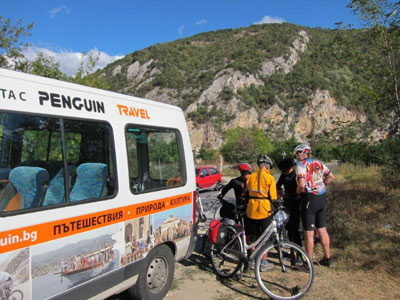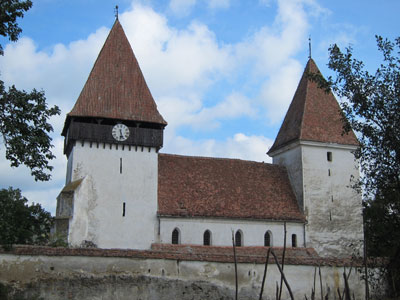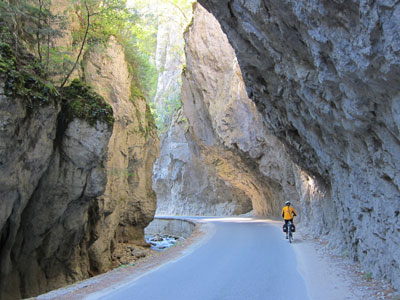Biking the backroads of Bulgaria and Romania
Bicycle travel is a wonderful way to explore different countries and gain a better understanding of the people and their cultures. My husband, Fred, and I, along with our friends Julane and Art, flew to Europe in September 2013 to cycle in the Transylvania region of Romania and the Rhodope Mountains of Bulgaria. Both adventures were booked through Bike Tours Direct (Chattanooga, TN; 877/462-2423).
We chose supported tours for our own comfort, and we opted to arrive a day early for each tour to allow time for travel/baggage delays and to adjust to the new time zone and languages.
Beginning in Brașov
Our flight left Washington Dulles in the evening and arrived at the Bucharest airport at about 4:30 p.m. A driver was waiting for us for the 2-hour trip to Brașov.
The next day, our free day, we explored the beautiful town of Brașov. We walked through the well-preserved, historic part of town and visited watchtowers, churches and museums. By the time we finished dinner that evening, we felt rested and comfortable with navigating around town.
Our tour officially started the following day, when a driver picked us up and transferred us to an inn in the small town of Zărnești, closer to the Făgăraș Mountains and Bran Castle. The agent from Bike Tours Direct delivered our bicycles, maps, cue sheets and tour information. She spoke excellent English and waited while we adjusted the bicycles and loaded our gear.
After putting jackets and snacks into our panniers, we set off, heading for Bran and its castle, commonly known as “Dracula’s Castle.” Even though the entrance area was crowded with tourist shops, we enjoyed our visit to the castle, as most of the displays had detailed information in English and visitors could wander through the many rooms at their leisure.
Saddle up
Over the next several days, our bicycle tour took us on a loop to the north and west, with overnights in Făgăraș, Sighișoara, Biertan, Nucet and Sibiu. Along the way, we cycled through rolling countryside and small Saxon villages.
There were many fortified Lutheran churches, the most impressive being the one in Biertan, the seat of the Lutheran bishop from 1572 to 1867. The fortress in Sighișoara was picturesque, with its impressive walls and water-filled moat, complete with swans.
On our next-to-last night on the tour, we were at a farmstay and were treated to a delicious home-cooked meal with local wine and a special walnut liquor.
The next morning, the owner and his friend transported us (and our bicycles) by horse cart to a nearby village.
Our tour ended in Sibiu. In the morning, we took a bus from there back to Bucharest, a 5½-hour trip that used up most of the day, since the bus was late. Fortunately, we had planned two nights in Bucharest, so we spent the following day on our own touring the highlights of the city, including Ceaușescu’s Palace of the Parliament and the interesting Museum of Romanian History.
During dinner on our last evening, we reflected on our journey and the contrasts between the bustling, European city of Bucharest and the small rural villages we had cycled through in Transylvania.
Under Hungarian rule, Saxon farmers settled in Transylvania beginning in the 12th and 13th centuries. To defend their villages from Turkish raiders, they fortified their churches. These churches, with their protective walls, and the German-style houses are still the distinctive features of the villages. However, most of the people of Saxon heritage have left these villages, which are now largely occupied by people of Roma, or “Gypsy,” heritage, who continue the subsistence farming and sheepherding that have been practiced in this region for centuries.
Our most memorable stay on this portion of the tour was at Pensiunea Bio Haus, the farm in Nucet where we had the horse cart ride over the mountain to the village of Sacadate.
On to Bulgaria
The next morning we caught the 8:30 flight from Bucharest to Sofia, Bulgaria, where a driver was waiting to transfer us to Plovdiv. After checking into our hotel, we had the afternoon and the next day to explore this interesting city, with its many Roman ruins, the well-maintained Old City area, featuring restored houses from the 19th-century National Revival period, and the vibrant city life along the Knyaz Aleksandar pedestrian mall.
Our Bulgarian riding tour started on Sunday morning, when our guide arrived with a van and our bicycles. Another bicycle tourist, a woman from Norway named Hilde, joined us for the tour.
Our guide, Zlatna Dimitrova, nicknamed Golda, spoke excellent English.
We loaded our baggage into the van, and Golda drove us westward into the Rila Mountains. A short distance before the town of Sestrimo, she parked the van so we could unload the bicycles, make adjustments and put the gear we wanted for the day into bags or panniers. Then we cycled into Sestrimo to buy snacks and food for our picnic. This short ride gave us a chance to check that our bicycles were OK.
After another short ride, we loaded the bicycles back into the van and drove up a narrow, steep road to Belmeken Dam. From there, we would cycle down to our town for the night, Velingrad.
Golda stayed close to us, either stopping on the road ahead or following behind as we cycled along.
That evening, after dinner in our hotel, she went over the plans for the week. Each evening, she would pass out the maps for the next day’s ride and explain where transport would be provided for us if the road were too steep or had too much traffic.
Most days, we cycled between 30 and 40 miles, with plenty of time to stop for photographs and a picnic lunch.
Our route took us southward into the Rhodope Mountains, then east to Smolyan and, finally, north toward Plovdiv.
We stayed at small family inns in Velingrad, Dospat, Trigrad, Smolyan and Borovo. The most picturesque was Hotel Tihia Kut, where our room looked out over the huge Dospat Reservoir, surrounded by dense pine forests.
The most memorable breakfast was at Hotel Uzunski in Smolyan. There, we were treated to big platters of freshly made Bulgarian mekitsi, puffy beignets, for our breakfast.
All our breakfasts and the evening meals, except those on our extra days in Plovdiv and our final tour night, were at our hotels and were included in the tour cost. Additionally, all the hotels, even in the most remote villages, had excellent Internet connections at no extra cost.
On two days we stopped at restaurants for lunch, and on the others we bought supplies and picnicked.
Our route took us through beautiful pine forests, along glacial lakes and past large reservoirs and small farms. The most impressive roads were those that took us through narrow gorges as we cycled up to reach the Yagodina and Devil’s Throat caves.
Our ride up the Buynovo Gorge to the Yagodina Cave was the most memorable bike ride we have ever taken. Cycling under the massive, overhanging rocks along the twisted road as we climbed up the gorge was amazing. Every turn took us to another wonderful view.
On our last cycling day, we visited the Miraculous Bridges (Chudnite Mostove), a group of large natural bridges near Laki. There, the Erkyupria River has eroded the marble mountains over eons, resulting in two large natural bridge formations. The largest has three vaults, with arches 147 feet high and 131 feet wide. The smaller bridge has an arch reaching 98 feet in height.
After hiking over and under the larger bridge, we had our picnic and then coasted nearly 30 miles downward to the entrance of the Bachkovo Monastery. We were able to tour some of the grounds of the monastery and view one chapel, but no photographs were allowed. After our bikes were loaded into the van, Golda drove us back to our hotel in Plovdiv.
We spent our final night in Plovdiv celebrating with a dinner in the Old Town. Golda picked us up the next morning for the transfer to Sofia Airport and our journeys homeward.
The details
Our 7-night Romanian tour, “Castles of Transylvania,” cost about $3,783 per couple and included the van transfer from the Bucharest airport to Brașov; an overnight in Brașov before the start of the tour; the bicycle rental for the week-long tour (with maps and cue sheets); seven hotel bookings; luggage transport between hotels, and two extra nights in Bucharest.
The 7-night Bulgarian tour, “Rhodopi – Mystic Mountains of the Balkans,” cost $2,883 per couple and included a driver/guide; bicycle rental; an extra night in Plovdiv; van transfers both ways between the Sofia airport and Plovdiv; five evening meals during the tour; luggage transfer; seven hotel bookings, and short transfers during the tour.
The round-trip airfare from Washington Dulles to Bucharest, returning from Sofia, was $2,306 per couple on British Airways. The flight from Bucharest to Sofia on Tarom cost $344 per couple. Additionally, our bus ride from Sibiu, Romania, back to Bucharest cost $20 per couple; the taxi to our hotel cost $10 per couple, and parking at Washington Dulles airport cost $100 per couple.
We spent an additional $900 per couple for trip insurance, meals, subway tickets, museum admissions, souvenirs and tips for our guide in Bulgaria during our 3-week adventure.





